Effect of Polishing Nozzle Wear Evolution on BK7 Topography
Abstract
1. Introduction
2. Methodology
2.1. Materials and Tools (Nozzle Design and Fabrication)
2.2. Simulation Results of Nozzle Cavity Erosion
2.3. Polishing Performance Evaluation Experiment of Nozzles
3. Results and Discussion
3.1. Surface Topography of Nozzles
3.2. Surface Topography of BK7
4. Conclusions
- (1)
- The nozzle 1 has the largest change in roughness, with a roughness change rate 30% to 44% higher than the other three areas and a roughness rate 6 times higher than the same area of the nozzle 2 after the 480 h test.
- (2)
- The price of each stainless steel nozzle is 450 RMB, while the price of each coated nozzle is 500 RMB according to the supplier’s quotation. In addition, there are labor costs, processing costs, warehouse costs, and so on. From an economic perspective, improving the wear resistance of nozzles means extending their lifespan.
- (3)
- Under the test conditions of transverse speed of 7.8 mm/min and polishing force of 2 MPa, nozzles 1 and 2 were used for polishing. The surface roughness of BK7 was 75 nm and 35 nm, while the PV values were 125 nm and 67 nm, respectively. The excellent quality of nozzle 2 (coated nozzle) is fully proven.
- (4)
- As one of the key components of the injection system, the nozzle’s working quality seriously affects the performance of the injection system. Nozzle blockage seriously affects the operation of the precision polishing experiment. The reason for the blockage is the polishing medium on the nozzle or impurities in the circulating medium blocking the nozzle path, which causes the blockage of the entire injection system, which then causes irreversible damage to the entire ultra-precision platform.
Author Contributions
Funding
Institutional Review Board Statement
Informed Consent Statement
Data Availability Statement
Conflicts of Interest
Nomenclature
| CNC SUN’5 Axis lathe | Computer numerical control |
| ZYGO | Laser scanning interferometer |
| AWJ | Abrasive water jet |
| Ra | Arithmetic mean deviation of the contour |
| BK7 | Optical glass |
| RMS | Root mean square/Roughness Measurement of the Surface |
References
- Santos, S.C.; Sales, W.F. Aspectos Tribológicos Da Usinagem Dos Materiais; Artliber Editora: Sao Paulo, Brazil, 2007. [Google Scholar]
- Kaladhar, M.; Subbaiah, K.V.; Rao, C.S. Machining of austenitic stainless steels—A review. Int. J. Mach. Mach. Mater. 2012, 12, 178. [Google Scholar] [CrossRef]
- Hoier, P.; Malakizadi, A.; Friebe, S.; Klement, U.; Krajnik, P. Microstructural variations in 316L austenitic stainless steel and their influence on tool wear in machining. Wear 2019, 428–429, 315–327. [Google Scholar] [CrossRef]
- Szczotkarz, N.; Mrugalski, R.; Maruda, R.W.; Królczyk, G.M.; Legutko, S.; Leksycki, K.; Dębowski, D.; Pruncu, C.I. Cutting tool wear in turning 316L stainless steel in the conditions of minimized lubrication. Tribol. Int. 2021, 156, 106813. [Google Scholar] [CrossRef]
- Wagner, V.; Duc, E. Study of Ti-1023 milling with toroidal tool. Int. J. Adv. Manuf. Technol. 2014, 75, 1473–1491. [Google Scholar] [CrossRef]
- Ginting, A.; Nouari, M. Experimental and numerical studies on the performance of alloyed carbide tool in dry milling of aerospace material. Int. J. Mach. Tools Manuf. 2006, 46, 758–768. [Google Scholar] [CrossRef]
- Rahman, M.; Kumar, A.S.; Available, N.; Salem, M.U. Evaluation of minimal of lubricant in end milling. Int. J. Adv. Manuf. Technol. 2001, 18, 235–241. [Google Scholar] [CrossRef]
- Chen, Z.; Lou, M.; Geng, D.; Xu, Y.X.; Wang, Q.; Zheng, J.; Zhu, R.; Chen, Y.; Kim, K.H. Effect of the modulation geometry on mechanical and tribological properties of TiSiN/TiAlN nano-multilayer coatings. Surf. Coatings Technol. 2021, 423, 127586. [Google Scholar] [CrossRef]
- Suárez, A.; de Lacalle, L.N.L.; Polvorosa, R.; Veiga, F.; Wretland, A. Effects of high-pressure cooling on the wear patterns on turning inserts used on alloy IN718. Mater. Manuf. Process. 2017, 32, 678–686. [Google Scholar] [CrossRef]
- Brunton, J.H. High speed liquid impact. Philos. Trans. R. Soc. Lond. Ser. A Math. Phys. Sci. 1996, 260, 79–85. [Google Scholar]
- Hutli, E.; Nedeljkovic, M.S.; Bonyár, A.; Radovic, N.A.; Llic, V.; Debeljkovic, A. The ability of using the cavitation phenomenon as a tool to modify the surface characteristics in micro- and in nano-level. Tribol. Int. 2016, 101, 88–97. [Google Scholar] [CrossRef]
- Li, D.; Chen, Q.; Cook, B. A further simulation study on the dual role of porosity in solid-particle erosion of materials. Wear 2011, 271, 1325–1330. [Google Scholar] [CrossRef]
- Narayanaswamy, B.; Hodgson, P.; Beladi, H. Effect of particle characteristics on the two-body abrasive wear behaviour of a pearlitic steel. Wear 2016, 354–355, 41–52. [Google Scholar] [CrossRef]
- Fernández-Abia, A.I.; Barreiro, J.; Fernández-Larrinoa, J.; de Lacalle, L.L.; Fernández-Valdivielso, A.; Pereira, O.M. Behaviour of PVD coatings in the turning of austenitic stainless steels. Procedia Eng. 2013, 63, 133–141. [Google Scholar] [CrossRef]
- Fernández-Abia, A.I.; Barreiro, J.; de Lacalle, L.N.L.; Martínez-Pellitero, S. Behavior of austenitic stainless steels at high speed turning using specific force coefficients. Int. J. Adv. Manuf. Technol. 2012, 62, 505–515. [Google Scholar] [CrossRef]
- Mehta, V.; Kumar, R.; Kumar, H. Performance of Composite Coating on Cutting Tools: Coating Technologies, Performance Optimization, and Their Characterization: A Review; Springer Press: Singapore, 2020. [Google Scholar]
- Qin, Y.; Zhao, H.; Li, C.; Lu, J.; He, J. Effect of heat treatment on the microstructure and corrosion behaviors of reactive plasma sprayed TiCN coatings. Surf. Coatings Technol. 2020, 398, 126086. [Google Scholar] [CrossRef]
- Chang, K.; Zheng, G.; Cheng, X.; Xu, R.; Li, Y.; Yu, Z.; Yang, X. Surface integrity evolution and wear evolution of the micro-blasted coated tool in high-speed turning of Ti6Al4V. Int. J. Adv. Manuf. Technol. 2021, 115, 603–616. [Google Scholar] [CrossRef]
- Chen, J.; Hu, H.; Chen, Y. Experimental investigation of micro-channel ejection based on a novel micro-fluidic coating nozzle. Surf. Coat. Technol. 2019, 358, 721–725. [Google Scholar] [CrossRef]
- Varadaraajan, V.; Mohanty, P. Design and optimization of rectangular cold spray nozzle: Radial injection angle, expansion ratio and traverse speed. Surf. Coatings Technol. 2017, 316, 246–254. [Google Scholar] [CrossRef]
- Fernandes, G.H.N.; Barbosa, L.M.Q.; França, P.H.P.; Martins, P.S.; Machado, Á.R. Towards green manufacturing: Investigating tool coatings and cooling strategies for Inconel 718 turning. Int. J. Adv. Manuf. Technol. 2023, 129, 2257–2279. [Google Scholar] [CrossRef]
- Jia, D.; Li, C.; Liu, J.; Zhang, Y.; Yang, M.; Gao, T.; Said, Z.; Sharma, S. Prediction model of volume average diameter and analysis of atomization characteristics in electrostatic atomization minimum quantity lubrication. Friction 2023, 11, 2107–2131. [Google Scholar] [CrossRef]
- Sidambe, A.T. Biocompatibility of Advanced Manufactured Titanium Implants—A Review. Materials 2014, 7, 8168–8188. [Google Scholar] [CrossRef]
- Zhu, R.; Zhu, H.; Zhang, X. Numerical investigation about the unsteady behavior of a free submerged cavitation jet using the SBES approach. Ocean Eng. 2024, 281, 115010. [Google Scholar] [CrossRef]
- Wang, Q.; Ning, D.; Hou, J.; Sun, L.; Gong, Y. Particle kinetic energy-based modeling and experimental study on abrasive waterjet coating removal. J. Clean. Prod. 2024, 444, 141108. [Google Scholar] [CrossRef]
- Liu, Z.; Xiao, L.; Duan, C.; Gao, C. Abrasive water jet polishing of TBC blocked inclination holes on superalloys using an optimized nozzle. J. Braz. Soc. Mech. Sci. Eng. 2023, 46, 22. [Google Scholar] [CrossRef]
- Song, Y.; Zhou, T.; Bai, R.; Zhang, M.; Yang, H. Assessment of the coating quality in a top-spray fluidized bed coater: An experimental study. Powder Technol. 2024, 439, 119663. [Google Scholar] [CrossRef]
- Slavkina, V.E.; Mirzaev, M.A.; Kuzmin, A.M.; Kutyrev, A.I.; Tuzhilin, S.P.; Denisov, V.A.; Kataev, Y.V. Testing of Polymer Composites for Manufacturing of Sprayer Nozzles. Polymers 2024, 16, 496. [Google Scholar] [CrossRef] [PubMed]
- Koller, M.; Cizek, J.; Janovská, M.; Ševčík, M.; Kondas, J.; Singh, R.; Seiner, H. Scanning Acoustic Microscopy Characterization of Cold-Sprayed Coatings Deposited on Grooved Substrates. J. Therm. Spray Technol. 2024, 33, 1941–1954. [Google Scholar] [CrossRef]
- Abruzzo, M.; Macoretta, G.; Romoli, L. Exploring scanning strategies for enhanced surface integrity in thin-walled nozzles. CIRP Ann. 2024, 73, 421–424. [Google Scholar] [CrossRef]
- Bierschenk, S.G.; Kovar, D. Micro-cold Spray Deposition of YSZ Films from Ultrafine Powders Using a Pressure Relief Channel Nozzle. J. Therm. Spray Technol. 2024, 33, 2022–2033. [Google Scholar] [CrossRef]
- Wang, R.; Wang, C. Effect of Micro Abrasive Slurry Jet Polishing on Properties of Coated Cemented Carbide Tools. Chin. J. Mech. Eng. 2023, 36, 132. [Google Scholar] [CrossRef]
- Qiang, Z.R. Research on the Erosion Mechanism and Processing Craft on Curved Surface by Abrasive Water Jet Polishing. Master’s Thesis, Jiangnan University, Wuxi, China, 2018. (In Chinese). [Google Scholar]
- Chen, X.; Yu, H.; Pan, H.; Chen, L.; You, H.; Liang, X. Nozzle Wear in Abrasive Water Jet Based on Numerical Simulation. Materials 2024, 17, 3585. [Google Scholar] [CrossRef] [PubMed]
- ISO 15510:2014; Stainless Steels—Chemical Composition: Stainless Steels. ISO: Geneve, Switzerland, 2014.
- ISO 4287:2009; Geometrical Product Specifications (GPS) — Surface texture: Profile method — Terms, definitions and surface texture parameters. ISO: Geneve, Switzerland, 2009.
- Pan, H.; Chen, X.; Chen, L.; You, H.; Liang, X. Surface Topography Analysis of BK7 with Different Roughness Nozzles Using an Abrasive Water Jet. Materials 2024, 17, 4494. [Google Scholar] [CrossRef] [PubMed]
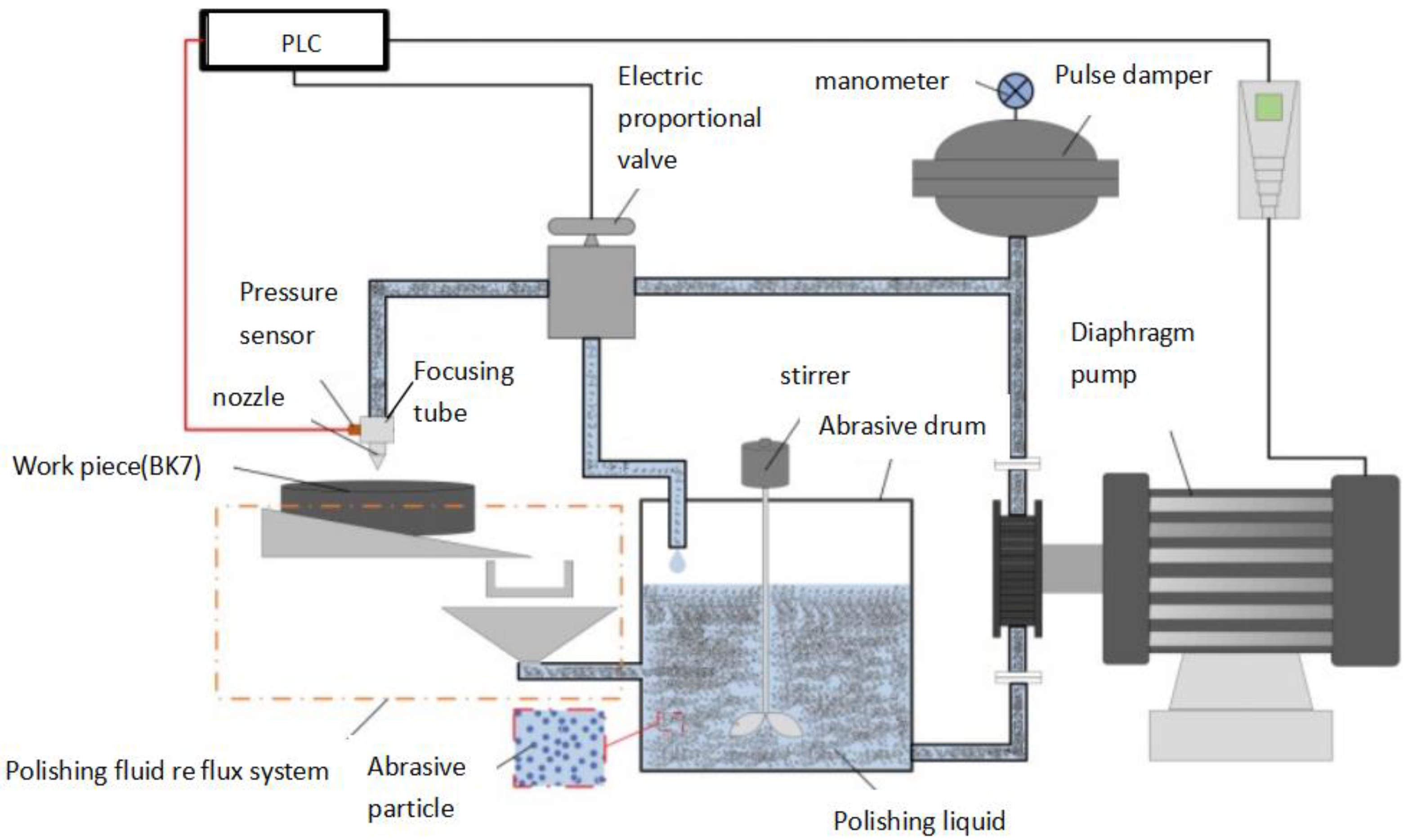
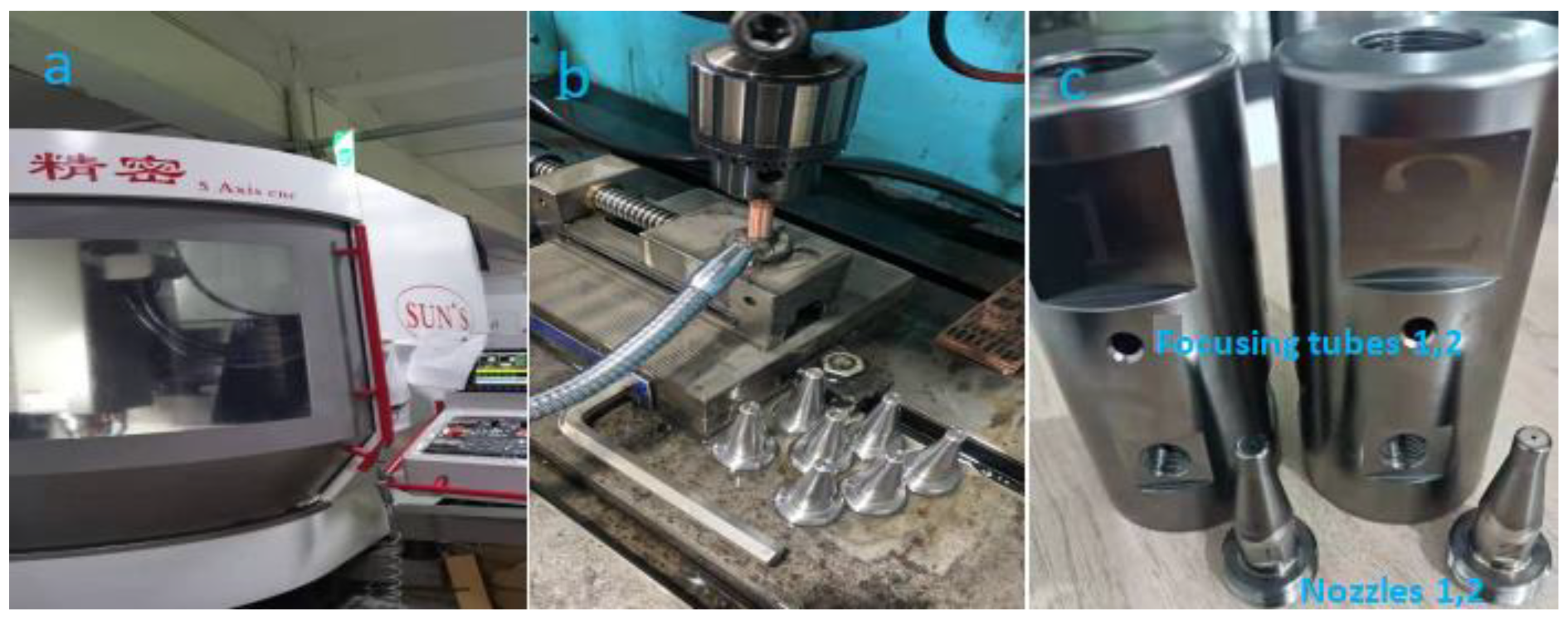
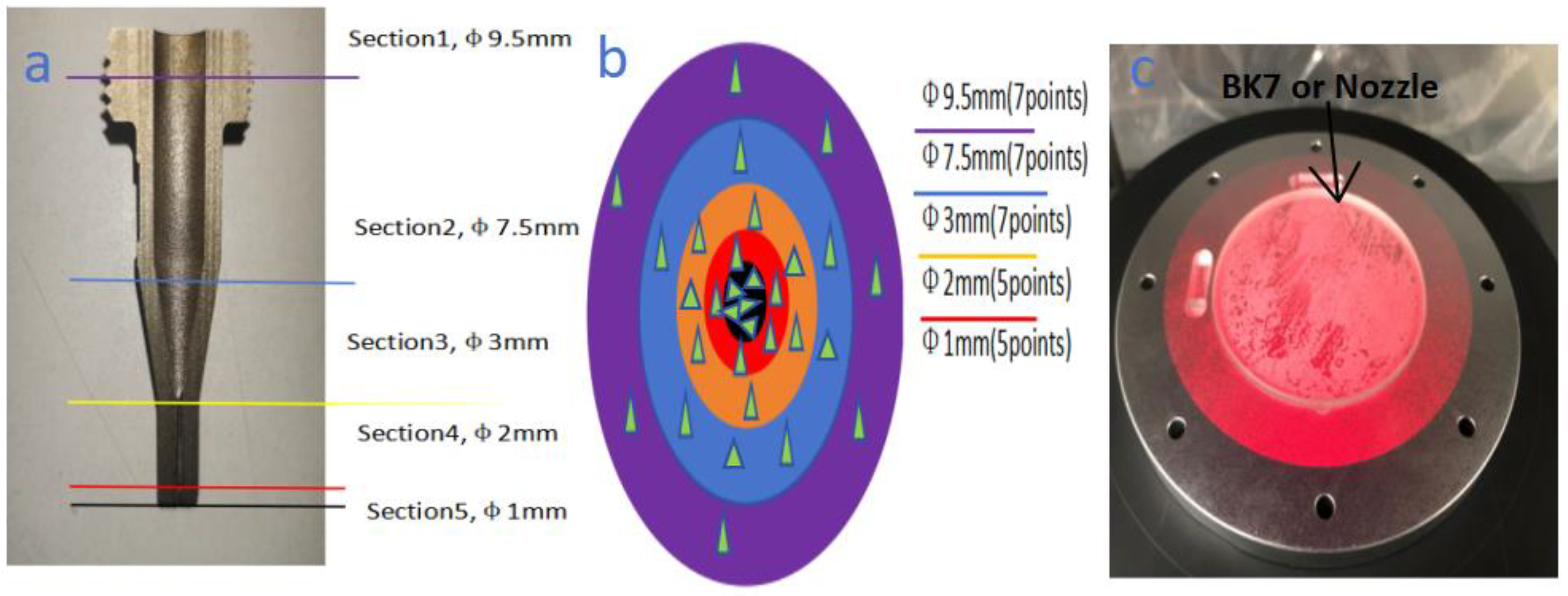
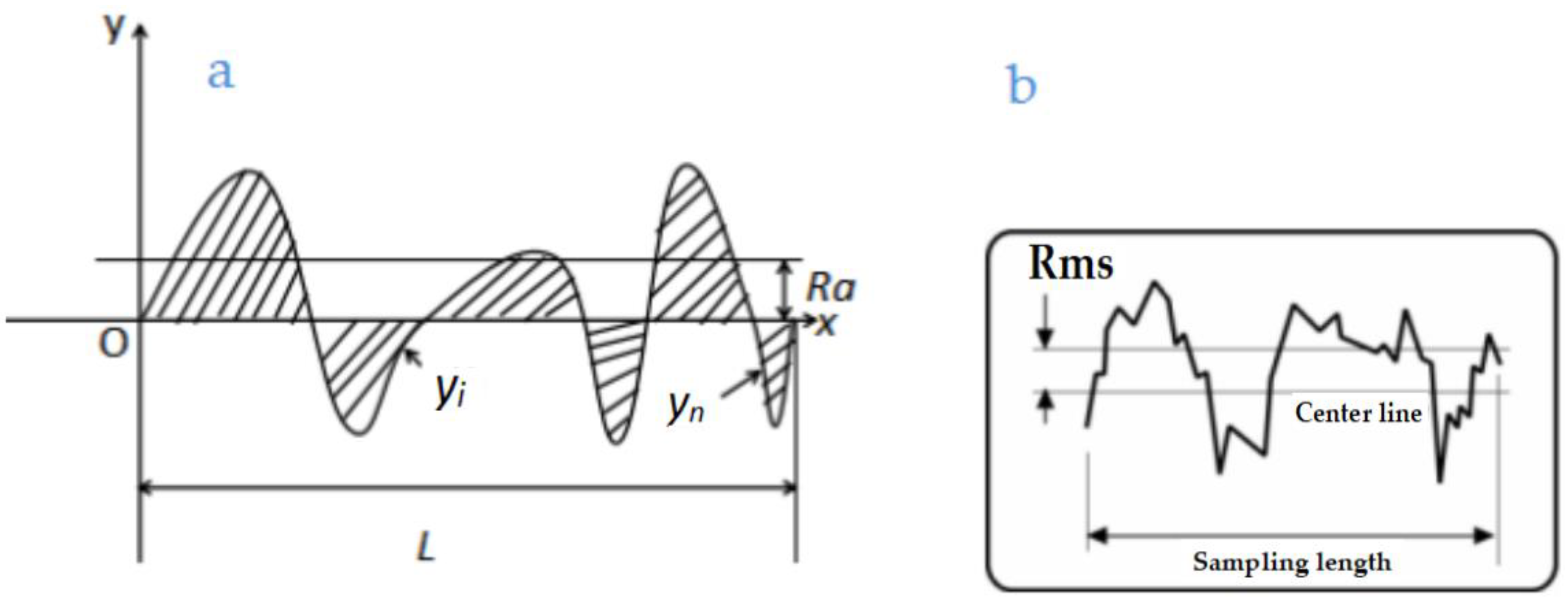
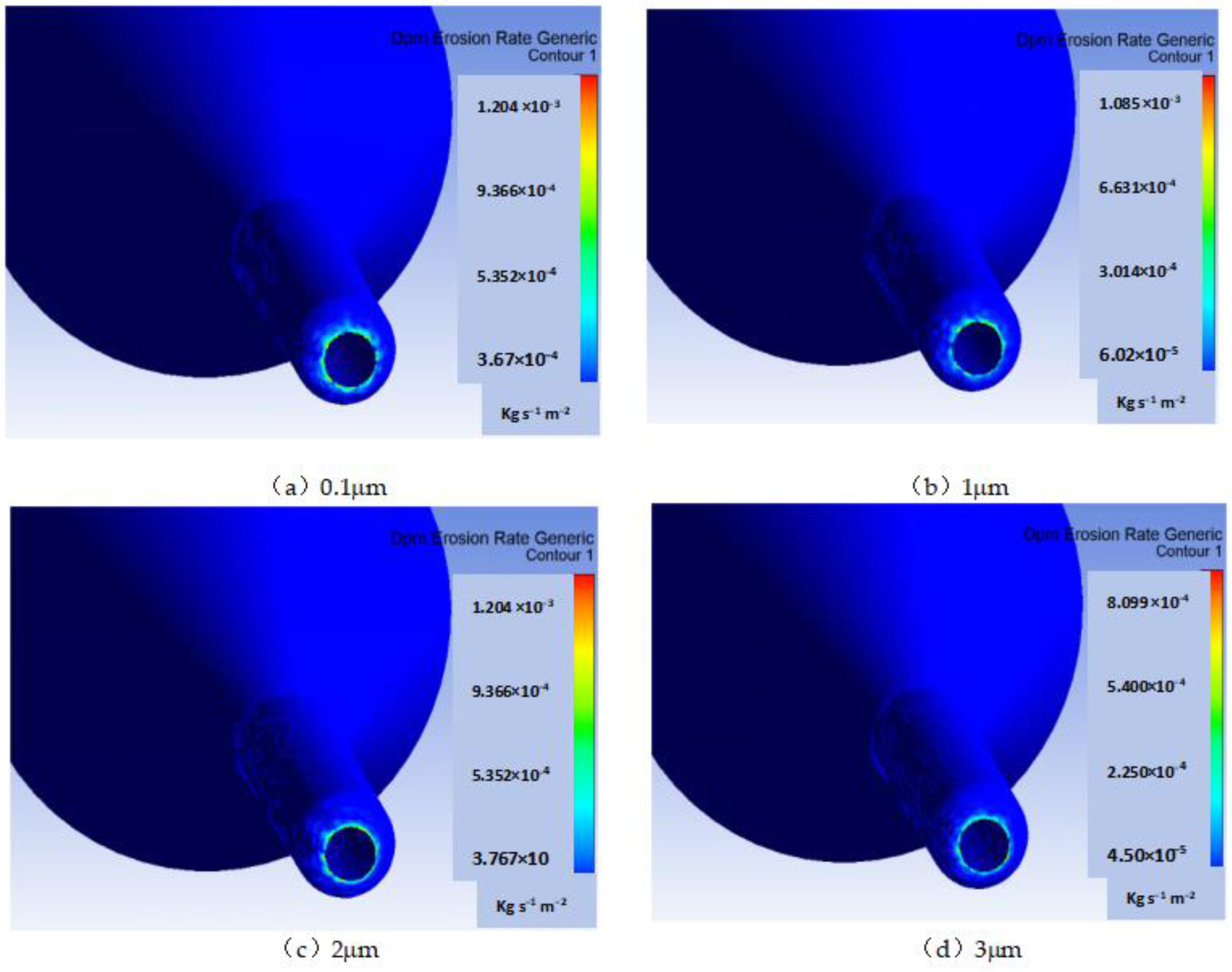
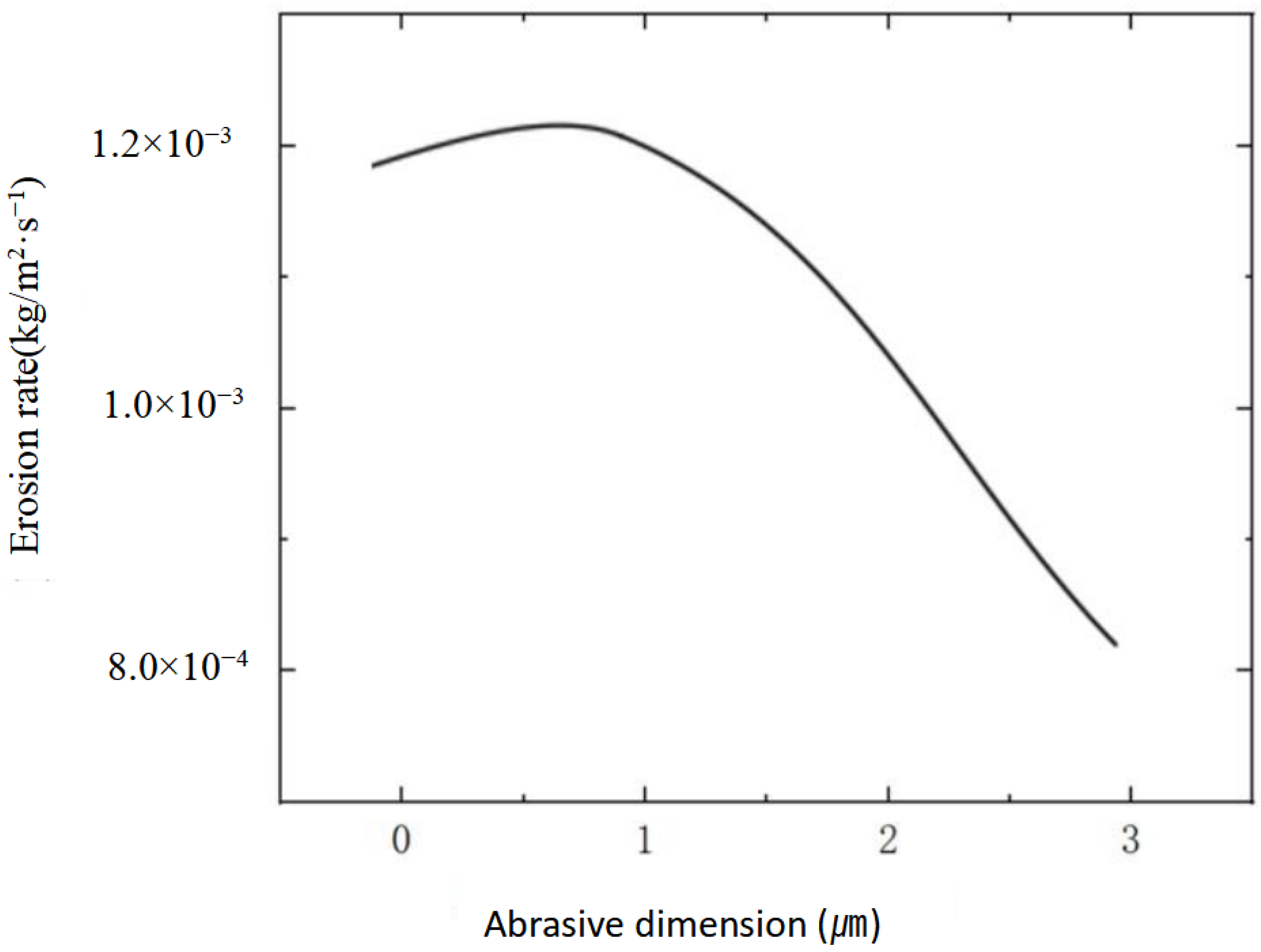

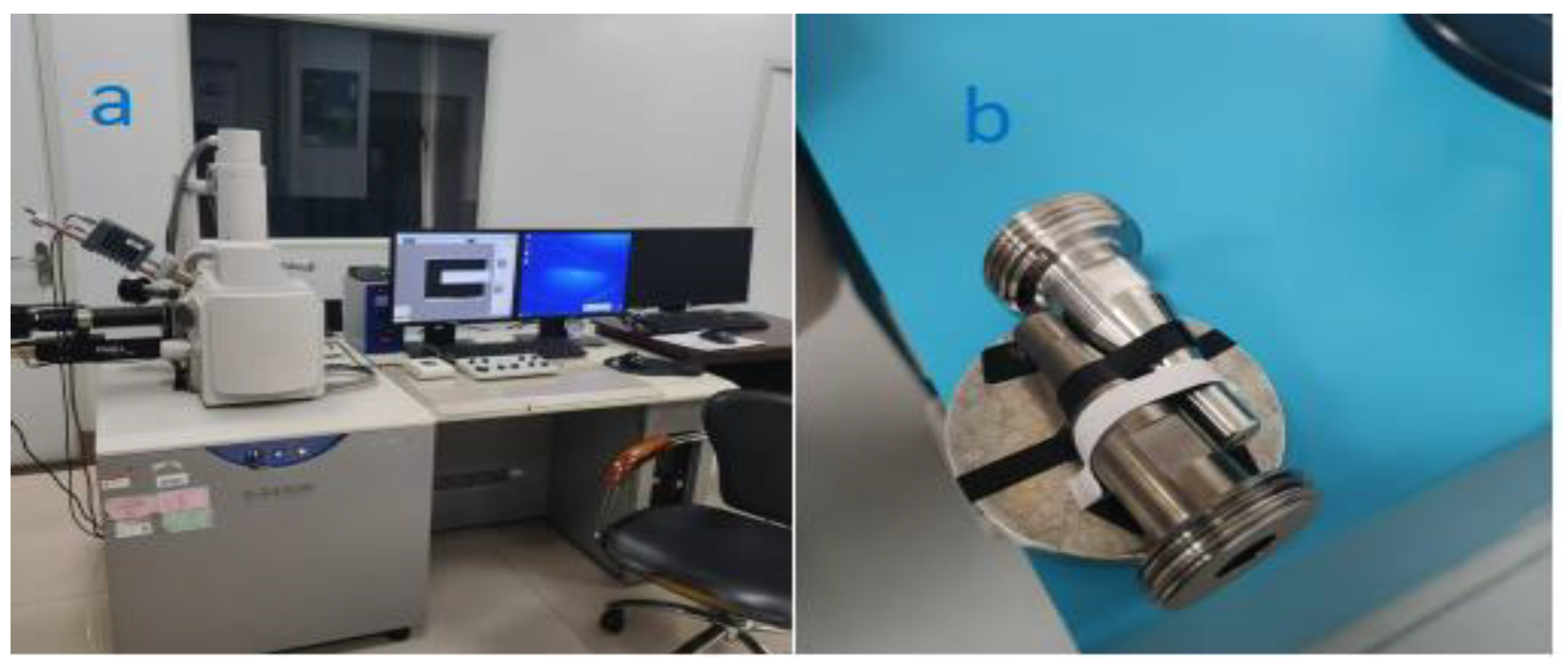




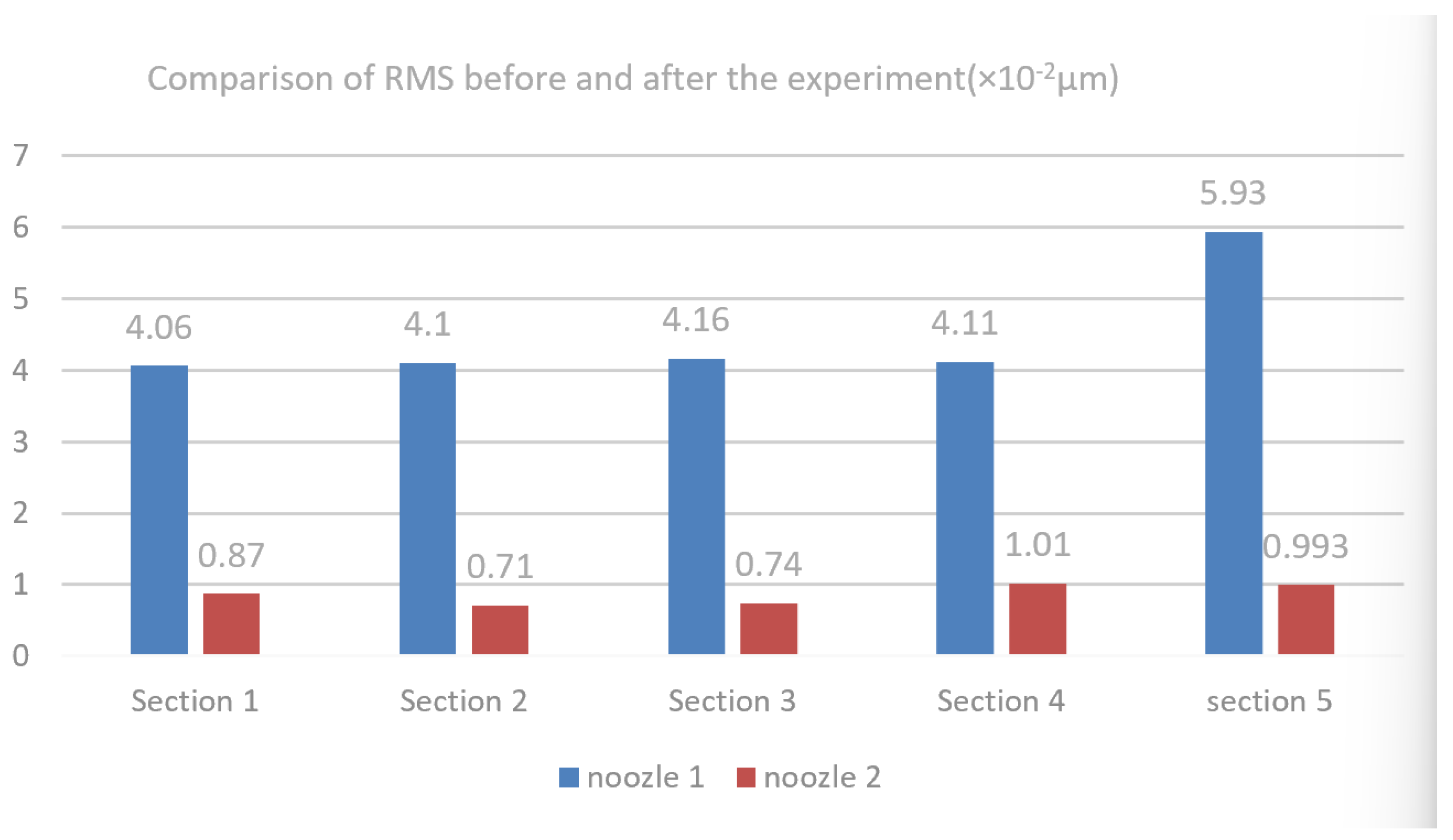
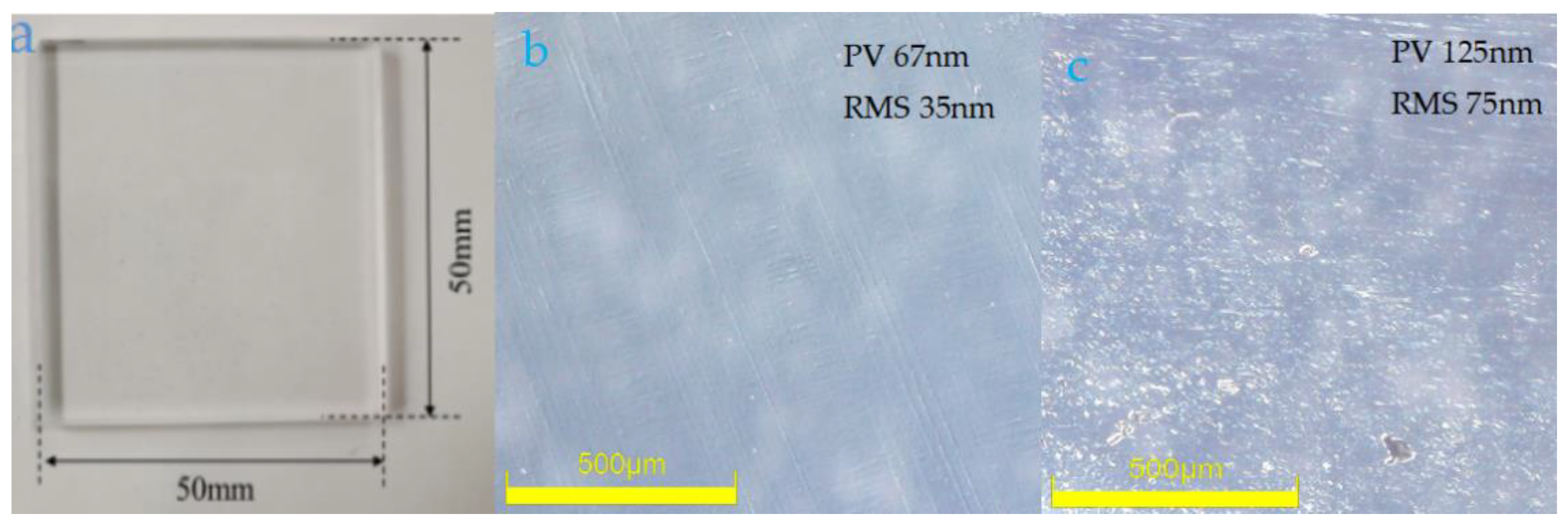
| Chemical Composition (%) | ||||||||
|---|---|---|---|---|---|---|---|---|
| C | Si | Mn | P | S | CR | NI | N | Balance |
| ≤0.08 | 0.75 | 2.0 MAX | 0.045 | 0.03 | ≥18 | ≥8 | 0.10 | Fe |
| Mechanical Properties | ||||||||
| Yield Strength (MPa) | Tensile Strength (MPa) | Elongation | Shrink Percentage | Elasticity Modulus | Poisson’s Ratio | |||
| ≥205 | ≥520 | δ5 (%) ≥ 40 | ψ (%) ≥ 60 | ≤200 | 0.247 | |||
| Physical Property | ||||||||
| Density | Specific Heat Capacity | Thermal Conductivity | Coefficient of Linear Expansion | |||||
| 7.93 g/cm3 | 0.50 kJ·kg−1·K−1 | 16.3 W·m−1·K−1 | 17.2 × 10−6·K−1 | |||||
| Inspected Items | RMS Before Polishing (nm) | |
|---|---|---|
| Nozzle Cavity (1) | Nozzle Cavity (2) | |
| Ø 9.5 (mm) hole (Section 1) | 107 | 146 |
| 102 | 95 | |
| 104 | 97 | |
| 89 | 106 | |
| 99 | 98 | |
| 95 | 96 | |
| 93 | 98 | |
| Ø 6 (mm) hole (Section 2) | 95 | 97 |
| 74 | 91 | |
| 77 | 99 | |
| 91 | 91 | |
| 94 | 96 | |
| 99 | 91 | |
| 84 | 93 | |
| Ø 3 (mm) hole (Section 3) | 97 | 95 |
| 76 | 92 | |
| 75 | 97 | |
| 93 | 94 | |
| 92 | 93 | |
| 96 | 94 | |
| 83 | 91 | |
| Ø 2 (mm) hole (Section 4) | 95 | 99 |
| 98 | 99 | |
| 96 | 110 | |
| 95 | 89 | |
| 61 | 73 | |
| Aperture Ø 1 (mm) outlet of nozzle (Section 5) | 98 | 89 |
| 95 | 195 | |
| 56 | 180 | |
| 48 | 150 | |
| 55 | 180 | |
| Inspected Items | Focusing Tube One Ra (μm) | Focusing Tube Two Ra (μm) | Judge OK or NG (μm) |
|---|---|---|---|
| Large inner hole | 1.323 | 1.149 | OK Ra ≤ 1.6 |
| Small inner hole | 0.472 | 0.519 | OK Ra ≤ 1.6 |
| Upper surface | 0.745 | 0.869 | OK Ra ≤ 1.6 |
| lower surface | 0.871 | 1.172 | OK Ra ≤ 1.6 |
| Parameters | Symbols | Unit | Value |
|---|---|---|---|
| Durability test | h | hour | 480 |
| Hydraulic pressure | p | Mpa | 2.0 |
| Mass flow rate of mixed liquid | v | L/min | 10 |
| Particle quality | - | Mesh (mm) | 80 (0.177) |
| Outlet diameter of nozzle | do | mm | 1 |
| Outlet diameter of focusing tube | df | mm | 10 |
| Angle of cutting head | j | ° | 90 |
| Particle diameter | - | 1000 nm, 500 nm | Al3O2 |
| Analysis Report of Figure 11c (Nozzle 1) | Analysis Report of Figure 12c (Nozzle 2) | ||||||||||||
|---|---|---|---|---|---|---|---|---|---|---|---|---|---|
| Elt. | Line | Intensity (c/s) | Atomic % | Atomic Ratio | Conc. | Units | Elt. | Line | Intensity (c/s) | Atomic % | Atomic Ratio | Conc. | Units |
| C | Ka | 680.28 | 52.397 | 2.6527 | 42.241 | wt.% | C | Ka | 104.62 | 37.023 | 3.4390 | 17.184 | wt.% |
| N | Ka | 71.93 | 23.503 | 1.1899 | 22.096 | wt.% | N | Ka | 44.80 | 22.379 | 2.0788 | 12.113 | wt.% |
| O | Ka | 125.56 | 19.752 | 1.0000 | 21.211 | wt.% | O | Ka | 45.57 | 10.766 | 1.0000 | 6.656 | wt.% |
| F | Ka | 0.00 | 0.000 | 0.0000 | 0.000 | wt.% | F | Ka | 0.25 | 0.043 | 0.0040 | 0.032 | wt.% |
| Al | Ka | 5.02 | 0.082 | 0.0041 | 0.148 | wt.% | Al | Ka | 3.82 | 0.212 | 0.0197 | 0.221 | wt.% |
| Si | Ka | 12.89 | 0.188 | 0.0095 | 0.354 | wt.% | Si | Ka | 22.66 | 1.066 | 0.0991 | 1.157 | wt.% |
| S | Ka | 53.91 | 0.707 | 0.0358 | 1.522 | wt.% | S | Ka | 26.59 | 1.052 | 0.0977 | 1.303 | wt.% |
| Ti | Ka | 12.94 | 0.230 | 0.0117 | 0.739 | wt.% | Ti | Ka | 2.60 | 0.115 | 0.0107 | 0.213 | wt.% |
| V | Ka | 2.31 | 0.045 | 0.0023 | 0.155 | wt.% | V | Ka | 0.85 | 0.042 | 0.0039 | 0.083 | wt.% |
| Cr | Ka | 16.71 | 0.368 | 0.0186 | 1.284 | wt.% | Cr | Ka | 101.00 | 5.483 | 0.5093 | 11.017 | wt.% |
| Fe | Ka | 78.60 | 2.599 | 0.1316 | 9.743 | wt.% | Fe | Ka | 225.73 | 19.486 | 1.8101 | 42.054 | wt.% |
| Ni | ka | 2.54 | 0.128 | 0.0065 | 0.506 | wt.% | Ni | Ka | 13.16 | 1.768 | 0.1642 | 4.010 | wt.% |
| Zn | ka | 0.00 | 0.000 | 0.0000 | 0.000 | wt.% | Zn | Ka | 0.30 | 0.068 | 0.0063 | 0.172 | wt.% |
| Total | 100.000 | 100.000 | wt.% | 100.000 | 100.000 | wt.% | |||||||
| Inspected Items | RMS After Polishing (nm) | |
|---|---|---|
| Nozzle (1) | Nozzle (2) | |
| Ø 9.5 (mm) hole (Section 1) | 484 | 206 |
| 481 | 200 | |
| 488 | 191 | |
| 480 | 192 | |
| 581 | 193 | |
| 493 | 177 | |
| 498 | 157 | |
| Ø 6 (mm) hole (Section 2) | 470 | 185 |
| 450 | 179 | |
| 491 | 177 | |
| 527 | 192 | |
| 591 | 193 | |
| 497 | 194 | |
| 490 | 192 | |
| Ø 3 (mm) hole (Section 3) | 491 | 154 |
| 484 | 168 | |
| 498 | 167 | |
| 528 | 199 | |
| 591 | 191 | |
| 490 | 197 | |
| 491 | 195 | |
| Ø 2 (mm) hole (Section 4) | 485 | 191 |
| 455 | 183 | |
| 487 | 185 | |
| 475 | 175 | |
| 508 | 183 | |
| Aperture Ø 1 (mm) outlet of nozzle (Section 5) | 966 | 223 |
| 1542 | 322 | |
| 1652 | 352 | |
| 1485 | 385 | |
| 1764 | 444 | |
Disclaimer/Publisher’s Note: The statements, opinions and data contained in all publications are solely those of the individual author(s) and contributor(s) and not of MDPI and/or the editor(s). MDPI and/or the editor(s) disclaim responsibility for any injury to people or property resulting from any ideas, methods, instructions or products referred to in the content. |
© 2025 by the authors. Licensee MDPI, Basel, Switzerland. This article is an open access article distributed under the terms and conditions of the Creative Commons Attribution (CC BY) license (https://creativecommons.org/licenses/by/4.0/).
Share and Cite
Chen, X.; Pan, H.; Chen, L.; You, H.; Liang, X. Effect of Polishing Nozzle Wear Evolution on BK7 Topography. Materials 2025, 18, 1796. https://doi.org/10.3390/ma18081796
Chen X, Pan H, Chen L, You H, Liang X. Effect of Polishing Nozzle Wear Evolution on BK7 Topography. Materials. 2025; 18(8):1796. https://doi.org/10.3390/ma18081796
Chicago/Turabian StyleChen, Xuhong, Haihong Pan, Lin Chen, Hui You, and Xubin Liang. 2025. "Effect of Polishing Nozzle Wear Evolution on BK7 Topography" Materials 18, no. 8: 1796. https://doi.org/10.3390/ma18081796
APA StyleChen, X., Pan, H., Chen, L., You, H., & Liang, X. (2025). Effect of Polishing Nozzle Wear Evolution on BK7 Topography. Materials, 18(8), 1796. https://doi.org/10.3390/ma18081796







